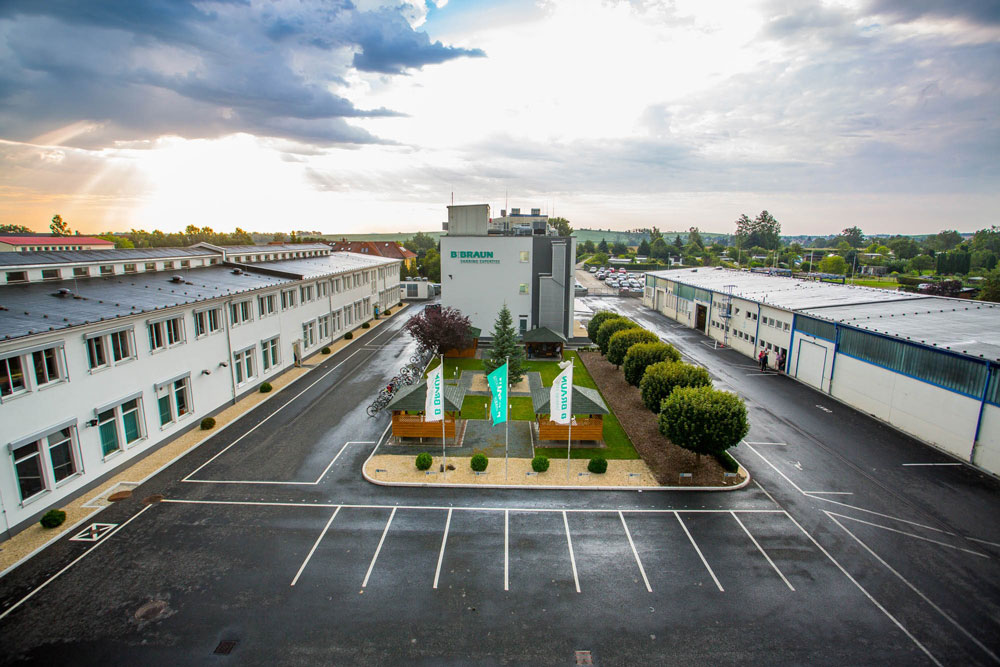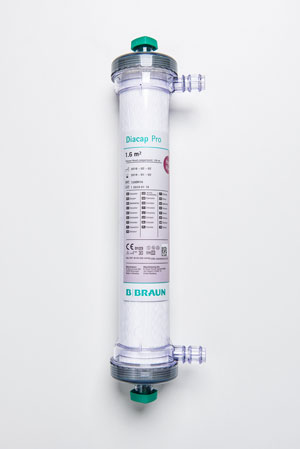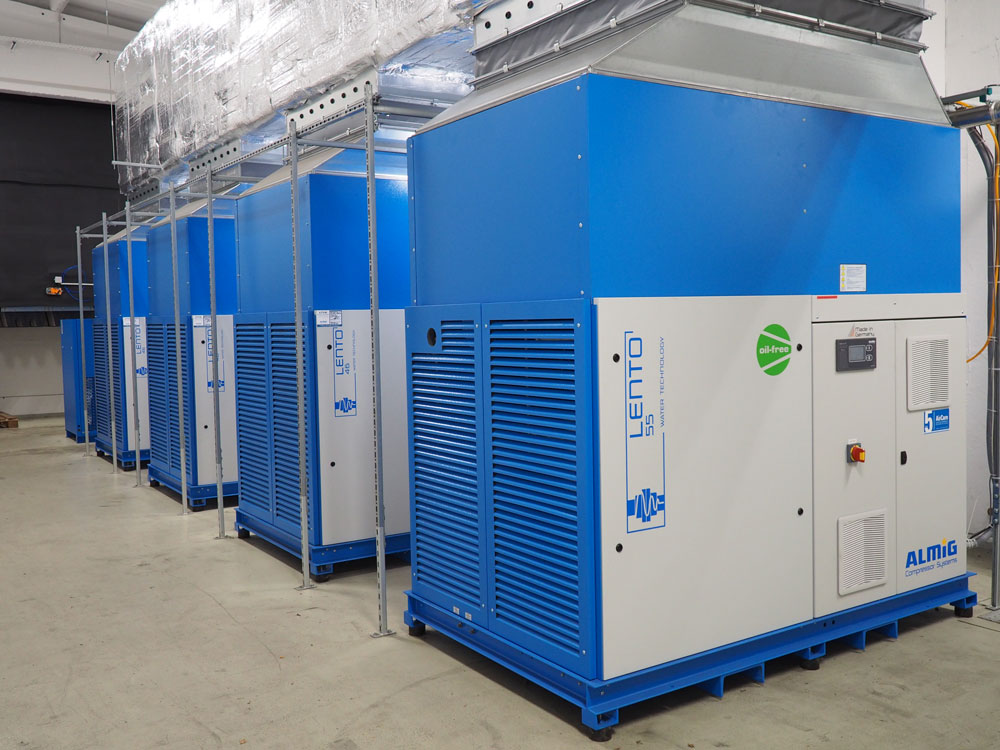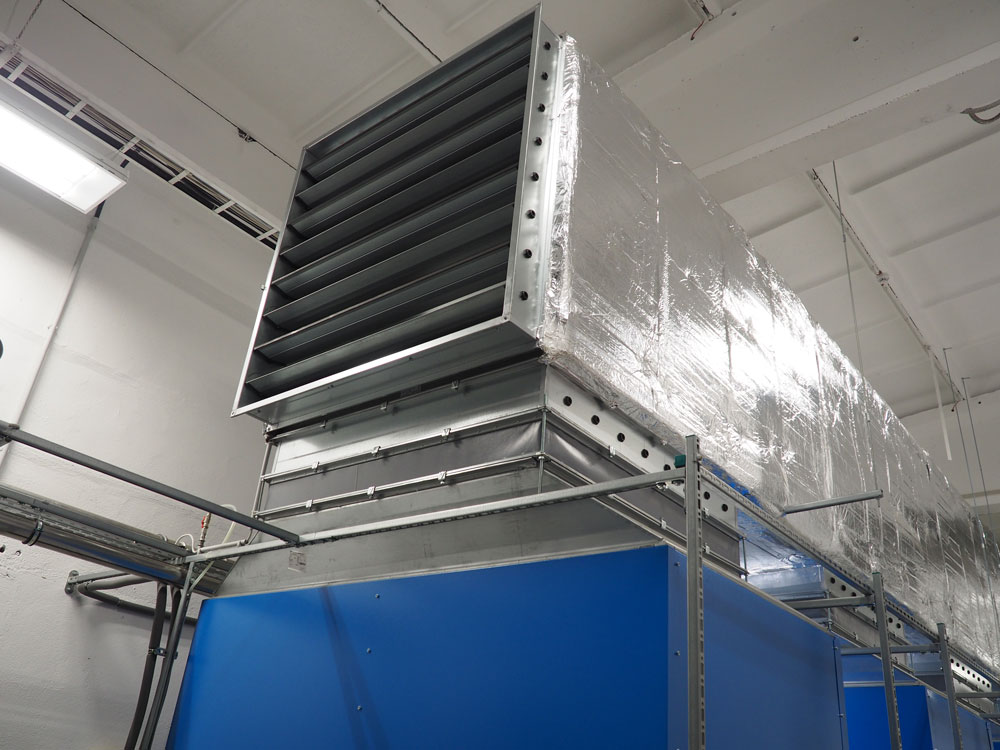News
B. Braun Avitum Saxonia GmbH relies on four oil-free LENTO screw compressors
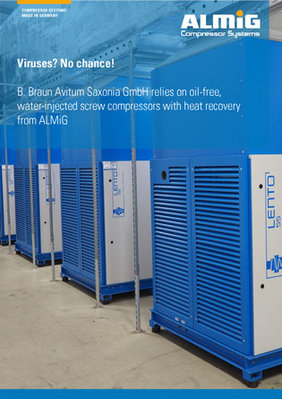
Dialysers are filter units for washing the blood of people with chronic kidney disease. B. Braun Avitum Saxonia GmbH is one of the world's largest manufacturers of these medical products. Compressed air plays a special role in assembly: hardly any machine runs without it. In order to ensure high availability of this medium despite the increasing demand for compressed air, the manufacturer has now added another system from this series to the three existing water-injected screw compressors in the LENTO 46 series from ALMiG. Special features: energy-efficient, oil-free and germ-free compressed air.
"The dialyser plays a central role in the dialysis therapy of patients with renal insufficiency. It acts as an 'artificial kidney' and takes over important functions of the natural organ," explains Dirk Hagen. He is Head of Facility Management at B. Braun Avitum Saxonia GmbH at the Dresden site in Radeberg, which is the largest employer in the town with around 600 employees. B. Braun Avitum Saxonia has been part of B. Braun Melsungen SE since 2004 and is one of the global market leaders in the manufacture of dialysis filters. In addition to Radeberg, the plants in neighbouring Wilsdruff and Berggießhübel form the Dresden site.
"Patients with renal insufficiency have to undergo dialysis three to four times a week for several hours. The dialyser uses various physical processes to remove toxins from the metabolism as well as excess water from the blood," continues Hagen. To do this, the patient's blood is passed through up to 15,000 hollow fibres in the dialyser, the walls of which consist of a thin semi-permeable membrane. This has precisely sized pores through which toxins and excess water are removed and essential blood components are retained. The performance and blood compatibility of the dialysers are crucial for the well-being of patients. The more biocompatible the materials of the dialyser are and the more effectively essential and toxic substances can be separated in the blood, the more effective the dialysis therapy will be. The manufacturer produces the high-tech fibres in Berggießhübel, while the dialysers are assembled in neighbouring Radeberg.
Absolutely oil-free air
Not much works in Radeberg without compressed air: the energy source supplies the pneumatic controls, drives cylinders and controls valves - applications where high compressed air quality is required, as production takes place in clean rooms. "We also use compressed air for wet leak testing the dialysers after assembly. And because the dialysers get wet during the process, we have to dry them with compressed air afterwards," says Hagen, describing two typical examples. "In these cases, the compressed air must be free of oil and germs and extremely low in particles." The plant has various compressed air networks available for the different qualities.
"Until 2017, we used oil-injected compressors to generate compressed air," explains Hagen. "To keep the compressed air oil-free, each system had its own treatment chain consisting of a cyclone separator, pre-filter, dryer, after-filter and activated carbon filter. Nevertheless, there was always a risk of contamination." The manufacturer wanted to rule this out completely. When the topic of energy efficiency became increasingly important in the company, those responsible looked at various concepts from different suppliers. In the end, ALMiG Kompressoren GmbH from Köngen, Swabia, near Munich, was able to convince them.
The right partner at your side
Uwe Herrmann is Managing Director of KFA Drucklufttechnik from Zwenkau, south of Leipzig. With his company, he offers maintenance and service as well as project management and sales of compressors. He is also a sales partner of ALMiG. "In an initial discussion, it quickly became clear that we could supply both the compressed air supply and all the necessary components from a single source, meaning that the customer would not have to work with different suppliers," explains Herrmann, leading the way to the compressor room with Dirk Hagen.
"We have set up an energy balancing system. This allows us to measure both compressed air consumption and power consumption," Herrmann explains. The software analyses the results and creates various simulations. Compressors are replaced in a targeted manner until the expert achieves the optimum energy result for the customer. The measurements were carried out both at off-peak times and at full capacity. After a detailed analysis, the expert recommended the LENTO 46 water-injected screw compressors from ALMiG with a volume flow of 8.6 cubic metres per minute. The system can supply up to 600 cubic metres of compressed air per hour. Three machines from this series had previously been used to cover the compressed air requirement.
Enough space for expansion
The previous systems were distributed throughout the plant. The new compressed air station was to be installed in a central location. To achieve this, B. Braun Avitum Saxonia separated off an area in the hall for a room large enough to expand the compressed air station if required. It took just three months from the ground-breaking ceremony to switch-on. The compressors run remarkably quietly.
Since summer 2020, there has also been a fourth machine in the room, a LENTO 55 with a volume flow of 8.19 cubic metres per minute, which can provide up to 600 cubic metres of compressed air per hour. "We've grown in recent years, and the demand for compressed air has increased as a result," reports Hagen. "We work here around the clock, seven days a week. We decided to invest in another machine as redundancy to ensure that the compressed air cannot fail under any circumstances."
Low speed, long service life
The LENTO systems have significantly lower maintenance costs compared to alternative technologies, such as dry-running screw compressors. "This is mainly due to their simple design," explains ALMiG expert Herrmann. "The compressor stages of water-injected screw compressors operate at four to five times lower speeds than the dry-running variant. This has a positive effect on the service life of the bearings and therefore on operational reliability." Water also has a much better heat absorption capacity compared to oil. "With these compressors, we have very low final compression temperatures of well below 60 degrees Celsius. The process is close to isothermal compression, which ensures better efficiency and therefore greater cost-effectiveness," explains Herrmann.
The speed control was also convincing. This allows the plant to react to the changing demand for compressed air. The compressors always produce the amount that is needed at any given time - and therefore only consume the corresponding amount of energy. When idling, standard compressors without speed control require around 25 to 40 per cent of the energy that is consumed under full load - without producing compressed air. The load-idle control of a standard compressor in conjunction with a fluctuating compressed air demand therefore causes expensive idle times.
By using screw compressors of the same size, it is possible to achieve even utilisation of the systems through constant base load changes. As the machines are always in the optimum speed range, both energy consumption and noise emissions are lower.
"The control systems are equipped with a balance monitoring system and a web server as standard," explains Herrmann. "This allows us to read out all relevant data online - for example, the running behaviour of the past operating days or weeks, how heavily the compressors are being used and when the next maintenance is due." It also records the amount of air consumed and the energy consumption. "If we notice that the operating behaviour changes significantly, we can react immediately," says Hagen. "With the old machines, we had a network pressure of around eight bar due to the higher-level control system. We were able to reduce the energy consumption by 1.5 bar in the total output." With a drive power of 80 to 135 kilowatts, this is a reduction of seven per cent - an important step towards saving CO2.
The Federal Office of Economics and Export Control (BAFA) agrees. With the support of ALMiG expert Herrmann, the plant in Radeberg was able to apply for funding from the Federal Office. Another good reason for the company why the investment in the new systems has paid off.
But even if the LENTO compressors work optimally at low temperatures, they convert a large proportion of the energy used into heat. To prevent this from simply going to waste, the systems are equipped with an integrated heat recovery system ex works. "We use this heat to heat our warehouse in the cold months," says Hagen, pointing up to the ceiling. The warm air is blown into the hall via a pipe.
Always fresh water
However, those responsible at B. Braun Avitum Saxonia were particularly impressed by the principle of washed compressed air, as used in the water-injected LENTO screw compressors. "The compressed air is cleaner than the fresh air drawn in for compression because the foreign particles it contains are effectively washed out by the circulating water," explains Herrmann. This has been confirmed by several independent, renowned institutes - including Fresenius. A refrigeration dryer is integrated into the LENTO system, which is an essential part of the water treatment process. "The compressor is filled with normal tap water during commissioning," explains the compressed air expert. "The condensate produced is collected at the condensate drain of the refrigeration dryer and fed back into the internal cooling circuit as fresh water." On average, the entire water volume is exchanged in this way once per shift.
The system therefore always works with fresh water. There is no need for a complex water treatment system. "The fresh water produced in this way is limescale-free. Viruses, bacteria and algae don't stand a chance. It can be discharged into the sewage system without treatment," says Herrmann.
"I was recently asked what happens if the compressor sucks in coronaviruses." The ALMiG expert adjusts his mask: "The temperature of the compressor alone would destroy all viruses in the compression process."
With the four compressors from ALMiG, B. Braun Avitum Saxonia always has enough compressed air on hand, even during high-load phases, and is also equipped for further growth. "We get exactly the quality of compressed air we need. It's cleaner than the air we breathe," says Hagen.


